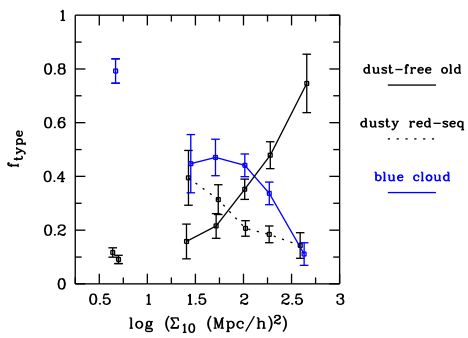Classifying
Objects by
Medium-Band
Observations
- a spectrophotometric
17-filter survey -
project: Watching field galaxies being transformed into cluster galaxies

Figure: The field environment ist dominated by blue star-forming galaxies, while the cluster cores are dominated by dust-free old and passively evolving red galaxies - this is the familiar colour-density relation. However, our newly identified dusty red galaxies are rare in the field and in the cores, but very common in the medium density habitat of cluster outskirts.
A long-standing mystery in galaxy evolution was why and how galaxies from the low-density field were transformed into galaxies in high-denisty clusters. This process not only involves their infall towards cluster cores, but it also changes the apperance of the galaxies to an enourmous extent. However, so far
galaxies had been observed mostly as either young dusty blue field galaxies or as old dust-free red cluster galaxies.
Now, we report the discovery of a rich component of dusty star-forming galaxies
contaminating the red-sequence in the supercluster system comprising Abell
901a, 901b and A902 at redshift 0.17. These galaxies do not fit into
the colour-density relation, because their preferred habitat is different
from that of regular red-sequence galaxies, which are typically dust-poor,
old and passively evolving. The dusty red galaxies prefer the medium-density
outskirts of clusters while being rare in both the low-density field and the
high-density cluster cores.
This new result is based on the information content in the medium-band
photometry of the COMBO-17 survey. The photo-z accuracy of the ~800
brightest cluster galaxies is <0.01 and of the order of the velocity
dispersion of the cluster. This enables us to select a rich and clean
cluster sample, in which we can trace age-sensitive and dust-sensitive
spectral features independently with the detailed medium-band SED data.
We speculate that the dusty red galaxies could either be a product of
minor mergers between established old red cluster galaxies with infalling
blue field galaxies, or mark a period in the internal transformation of
blue field galaxies into red cluster galaxies, which is triggered by the
environmental influences experienced during cluster infall.
Contact person: Chris Wolf, Oxford
Back to COMBO-17 science page
Last update July 7, 2005, CW
